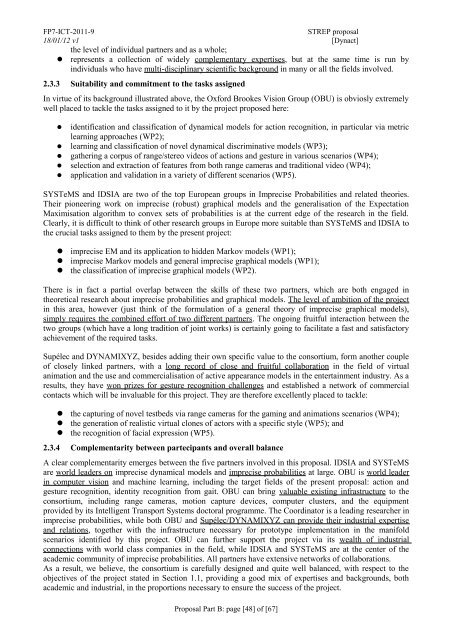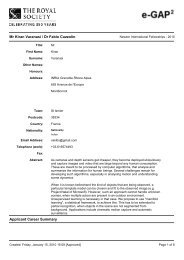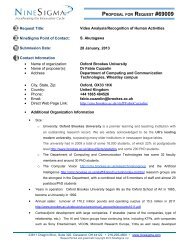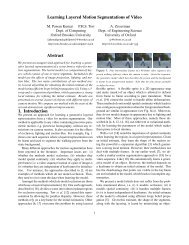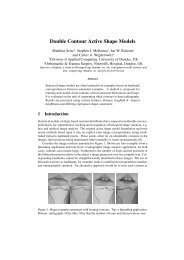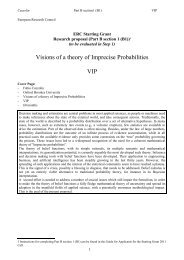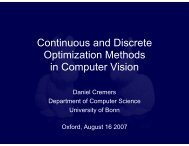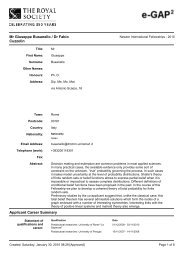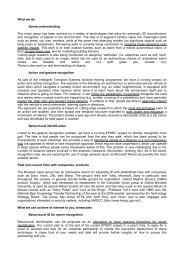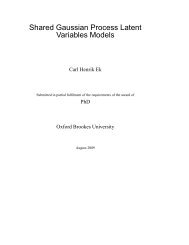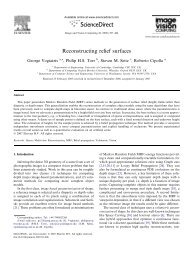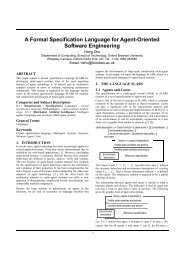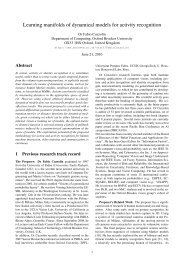Project Proposal (PDF) - Oxford Brookes University
Project Proposal (PDF) - Oxford Brookes University
Project Proposal (PDF) - Oxford Brookes University
You also want an ePaper? Increase the reach of your titles
YUMPU automatically turns print PDFs into web optimized ePapers that Google loves.
FP7-ICT-2011-9 STREP proposal<br />
18/01/12 v1 [Dynact]<br />
the level of individual partners and as a whole;<br />
represents a collection of widely complementary expertises, but at the same time is run by<br />
individuals who have multi-disciplinary scientific background in many or all the fields involved.<br />
2.3.3 Suitability and commitment to the tasks assigned<br />
In virtue of its background illustrated above, the <strong>Oxford</strong> <strong>Brookes</strong> Vision Group (OBU) is obviosly extremely<br />
well placed to tackle the tasks assigned to it by the project proposed here:<br />
identification and classification of dynamical models for action recognition, in particular via metric<br />
learning approaches (WP2);<br />
learning and classification of novel dynamical discriminative models (WP3);<br />
gathering a corpus of range/stereo videos of actions and gesture in various scenarios (WP4);<br />
selection and extraction of features from both range cameras and traditional video (WP4);<br />
application and validation in a variety of different scenarios (WP5).<br />
SYSTeMS and IDSIA are two of the top European groups in Imprecise Probabilities and related theories.<br />
Their pioneering work on imprecise (robust) graphical models and the generalisation of the Expectation<br />
Maximisation algorithm to convex sets of probabilities is at the current edge of the research in the field.<br />
Clearly, it is difficult to think of other research groups in Europe more suitable than SYSTeMS and IDSIA to<br />
the crucial tasks assigned to them by the present project:<br />
imprecise EM and its application to hidden Markov models (WP1);<br />
imprecise Markov models and general imprecise graphical models (WP1);<br />
the classification of imprecise graphical models (WP2).<br />
There is in fact a partial overlap between the skills of these two partners, which are both engaged in<br />
theoretical research about imprecise probabilities and graphical models. The level of ambition of the project<br />
in this area, however (just think of the formulation of a general theory of imprecise graphical models),<br />
simply requires the combined effort of two different partners. The ongoing fruitful interaction between the<br />
two groups (which have a long tradition of joint works) is certainly going to facilitate a fast and satisfactory<br />
achievement of the required tasks.<br />
Supélec and DYNAMIXYZ, besides adding their own specific value to the consortium, form another couple<br />
of closely linked partners, with a long record of close and fruitful collaboration in the field of virtual<br />
animation and the use and commercialisation of active appearance models in the entertainment industry. As a<br />
results, they have won prizes for gesture recognition challenges and established a network of commercial<br />
contacts which will be invaluable for this project. They are therefore excellently placed to tackle:<br />
the capturing of novel testbeds via range cameras for the gaming and animations scenarios (WP4);<br />
the generation of realistic virtual clones of actors with a specific style (WP5); and<br />
the recognition of facial expression (WP5).<br />
2.3.4 Complementarity between partecipants and overall balance<br />
A clear complementarity emerges between the five partners involved in this proposal. IDSIA and SYSTeMS<br />
are world leaders on imprecise dynamical models and imprecise probabilities at large. OBU is world leader<br />
in computer vision and machine learning, including the target fields of the present proposal: action and<br />
gesture recognition, identity recognition from gait. OBU can bring valuable existing infrastructure to the<br />
consortium, including range cameras, motion capture devices, computer clusters, and the equipment<br />
provided by its Intelligent Transport Systems doctoral programme. The Coordinator is a leading researcher in<br />
imprecise probabilities, while both OBU and Supélec/DYNAMIXYZ can provide their industrial expertise<br />
and relations, together with the infrastructure necessary for prototype implementation in the manifold<br />
scenarios identified by this project. OBU can further support the project via its wealth of industrial<br />
connections with world class companies in the field, while IDSIA and SYSTeMS are at the center of the<br />
academic community of imprecise probabilities. All partners have extensive networks of collaborations.<br />
As a result, we believe, the consortium is carefully designed and quite well balanced, with respect to the<br />
objectives of the project stated in Section 1.1, providing a good mix of expertises and backgrounds, both<br />
academic and industrial, in the proportions necessary to ensure the success of the project.<br />
<strong>Proposal</strong> Part B: page [48] of [67]


